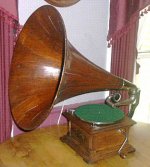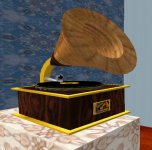This formula is often quoted, but quite wrong! It may explain why some people think they can hear capacitors; they have used the wrong value.
The R in the formula is not the cathode resistor, but the parallel combination of the cathode resistor with 1/gm - using gm at your chosen operating point not merely the one quoted in the valve datasheet.
In some cases what people may be hearing is a combination of wrong (usually too low) value combined with wide tolerance of electrolytics. The result is inter-channel phase shift at low frequencies; the capacitors take the blame when all they are doing is what it says on the can: 100uF +-20% when maybe you actually need 220uF +-5% or 1000uF +-20%.
Right there is where you go wrong, so nothing past that is correct, either. Draw the equivalent circuits of one amplifying stage RC coupled to another, then calculate the transfer functions. Note that the AC voltage across the cap is proportional to Xc/(R + Xc). Now, what are the ways to minimize that quantity?
Engineering. Very basic engineering. It's not hard, but you gotta do it.
Both of which mean a very small ac voltage across the capacitor. Which is the whole point - coupling and decoupling capacitors should be as near a short circuit as possible at the frequencies of interest, else they don't do the job they are supposed to do, and if they are near short circuits there can be very little voltage across them and they make no difference to the signal and hence the sound.
Cheers
Ian
These things make the forum something unique.
May be very basic engineering, but more than one is overlooked.
Thank you guys !

and the best bypass capacitor is.......no capacitor.....
And the best amp is...no amp
Attachments
A Hammond H100 organ with 45 year old power amp bypass capacitors has all the bass of a kazoo. New OEM sized capacitors later, the bass will shake the glass in the chandelier. Try it yourself, H100's are usually free.and the best bypass capacitor is.......no capacitor.....
I started at the power rectifier tubes and worked out with new caps. Before the bypass caps, the power amp also had new B+ caps. But then the bypass caps made a big difference.
Last edited:
Because some capacitors sound better than others, in my system, with my ears and my speakers/headphones.
i have no problem with this, after all it is your system, this is you truth, there are other truths out there from others...
Sorry, but I don't build amps that "just work". If that's what you do, ok, it's your business.
I, for one, want the best musical experience out of my amps, and I do everything I can to get it.
i build my gears to please me and no other....i will avoid capacitors where i can, or just use the least amount i can get away with.....
capacitors serve a purpose in any circuit, and to sound good is not one of them, i view my builds on the sum of its parts, not just caps...an amp can have 30 parts and the caps are just a fraction of those parts...
i post so that newbies will know there are alternatives to having a capacitor beliefs....
Polyester. Known to be a slightly non-linear dielectric, so need to ensure no signal voltage across them (except in guitar amps and old radios, where a little extra distortion is either required or unimportant).
What do you mean by 'high performance circuits'? I would assume that 'capacitor sound' is a symptom of a low performance circuit.
Which goes to show that capacitors have a sound impact. Quite an admission from the Engineers approach.
However I believe you are talking about a different beast to me, I am referencing MKT-P rectangular caps. I would have to disagree you assessment - slightly smoothed top end but lacking in any other impacts.
Shoog
So,
what can be taken from this thread is..if your a DIYer...You will hear caps because your designs are most likley not very good..
If you buy and modify HIFI kit you will hear caps because its not well designed..
Quad were not very good either at tube amps because you can hear a change...As were many others..
If you have global FB and its properly designed you will not hear any change..
So for most people you will hear a change because you are always listening to rubbish gear... ..Live long and prosper (Dr Spock)
..Live long and prosper (Dr Spock)
Regards
M. Gregg
what can be taken from this thread is..if your a DIYer...You will hear caps because your designs are most likley not very good..
If you buy and modify HIFI kit you will hear caps because its not well designed..
Quad were not very good either at tube amps because you can hear a change...As were many others..
If you have global FB and its properly designed you will not hear any change..
So for most people you will hear a change because you are always listening to rubbish gear...
Regards
M. Gregg
Last edited:
On the other hand,
If your gear is properly designed you won't hear any cap changes...because its all DC coupled and you don't have any..
However if a heater fails the amp will instantly self destruct..so you always have fresh components and nothing left to compare it to...
Regards
M. Gregg
If your gear is properly designed you won't hear any cap changes...because its all DC coupled and you don't have any..
However if a heater fails the amp will instantly self destruct..so you always have fresh components and nothing left to compare it to...
Regards
M. Gregg
We are always happy to 'admit' facts. However, even polyester caps will not modify the sound if they are used correctly.Shoog said:Which goes to show that capacitors have a sound impact. Quite an admission from the Engineers approach.
Two different design approaches:
- choose caps to get the sound you prefer
- design circuit so caps don't matter (apart from the one setting the LF rolloff)
Only one of these is hi-fi.
On the other hand,
If your gear is properly designed you won't hear any cap changes...because its all DC coupled and you don't have any..
However if a heater fails the amp will instantly self destruct..so you always have fresh components and nothing left to compare it to...
Regards
M. Gregg
Indeed.
Shoog
what can be taken from this thread is..if your a DIYer...You will hear caps because your designs are most likley not very good..
Some diyers build poor designs. Some build excellent designs.
Some people can read. Some can't.
Generalizing can be a great source of error.
It seems to me that this is wishful thinking. Even in gNFB designs changing coupling caps changes the sound - though to a lesser extent than those using zeroNFB or local feeback.We are always happy to 'admit' facts. However, even polyester caps will not modify the sound if they are used correctly.
Two different design approaches:
- choose caps to get the sound you prefer
- design circuit so caps don't matter (apart from the one setting the LF rolloff)Only one of these is hi-fi.
I would like to see these perfect amps, and then I would like to see if I actually like the sound of them - which is a different matter.
Shoog
we are talking cathode bypass caps are we not?
Yes- the same rules apply, a competent design for a hifi amp will not have any significant signal voltage across the cap. Minimization of that signal is accomplished the same way as minimization of signal across coupling caps. DF96 was kind enough to provide the correct method of determining the "R" part of the equation. This is also discussed thoroughly in Morgan Jones's book, along with ways to maximize that "R."
If I could build a perfect amp I would do what I always do: get used to the sound of it. I would not seek to introduce pleasant imperfections, or claim that it has (unspecified) immeasurable but audible problems which are not shared by measurably more distorting amps.Shoog said:I would like to see these perfect amps, and then I would like to see if I actually like the sound of them - which is a different matter.
Its a bit like a voltmeter: when I buy a DMM I don't fiddle with the innards until it gives me the readings I desire; I just accept that it is doing its best to correctly (but of course imperfectly) present the actual circuit voltage. If I don't like the reading that is just tough.
Overall I would tend to agree that correct design will minimize the sonic impacts of cap choices, but they still exist and observational evidence provides ample evidence for this.
For me, low impedence drive and DC coupling or transformer coupling is the best cure for the choice of cap.
Shoog
For me, low impedence drive and DC coupling or transformer coupling is the best cure for the choice of cap.
Shoog
Generalizing can be a great source of error.
I don't see how its a generalisation..Statement...in a corectly designed amp you cannot hear the sound of components..in this case a capacitor in the cathode of a tube..
In reverse..if you can its not correctly designed..
Its either correct or its not...Its no good then saying well some people build correctly designed amps and they can hear a difference.. so the get out is they think they can hear a difference...but its correctly designed. So in tests there actually is no difference.
The next thing is well it doesnt show on any readings in any lab..I agree...
And yes thank's to DF96 for pointing out the Formula..I'm not averse to engineering..
Regards
M. Gregg
Last edited:
As I said - if this approach were the ideal - we would all be using opamps.If I could build a perfect amp I would do what I always do: get used to the sound of it. I would not seek to introduce pleasant imperfections, or claim that it has (unspecified) immeasurable but audible problems which are not shared by measurably more distorting amps.
Its a bit like a voltmeter: when I buy a DMM I don't fiddle with the innards until it gives me the readings I desire; I just accept that it is doing its best to correctly (but of course imperfectly) present the actual circuit voltage. If I don't like the reading that is just tough.
The fact that we are not tells you something about the inadequacies of the ideal.
Shoog
I don't see how its a generalisation..
OK, then it's reading which is the problem. Fortunately, some are able to read the clear explanations given by Ian, Dave, and me, and act on them in their design work. A diy design can be done competently and often is.
I think the main issue here (and it pops up again and again) is the desire to build an effects box rather than a hifi amp (not a problem) coupled with strenuous denial that this is the goal (big problem).
- Status
- This old topic is closed. If you want to reopen this topic, contact a moderator using the "Report Post" button.
- Home
- Amplifiers
- Tubes / Valves
- Cathode Bypass Capacitor


